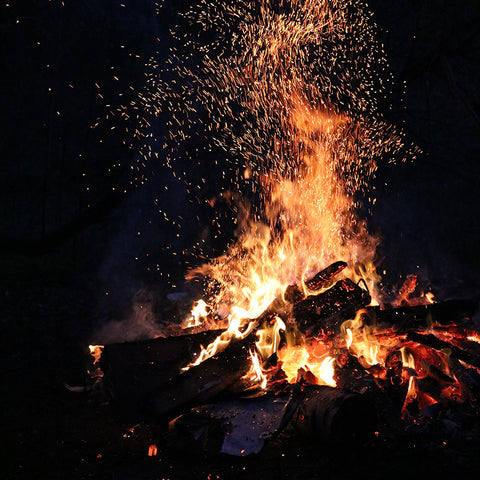
Every year, dozens of hikers, campers, hunters, and fishermen get lost in the wilderness. These individuals require rescue from the forest service in the area. However, help is not always right around the corner.
If you find yourself lost in the wilderness, you must prioritize how you spend your time. The Rule of Threes states that you can only survive three hours in the wild without fire or shelter. Especially if you are cold or wet, hypothermia can set it. This is actually the number one reason why people die in wilderness survival scenarios.
You can build a shelter and should at some point, but that takes time. The faster option to get warm is a fire. However, starting a fire in the wilderness can be difficult. This is even more true if you are dealing with wet or windy conditions. In this article, we will cover the fastest ways to get a fire going and help you survive in the wild.
Gathering Materials
The most important step in starting a fire is gathering the right natural materials in the right amounts. Tinder is the dry, fine material needed to take a spark or flame. If there is any moisture, your tinder could be ruined. If it is dry, dead leaves, dead grass, and dry evergreen needles can work. If it has been raining, you can find cattail fluff, bird’s nests, birch bark, or pine resin. These materials will light up even when it is raining or windy. You will want a tinder bundle big enough to just fit your hands around it.
You can also bring tinder materials from home if you like. Cotton balls rubbed in petroleum jelly, pencil shavings, and dryer lint can all be found at home for tinder. You can also buy tinder like Wetfire Cubes or Firestix. These materials are designed to stay lit for 10 to 30 minutes even in the wind and rain.
Next you will need your kindling. These are the smaller sticks needed to get fuel logs going. You want dry sticks anywhere from pencil thickness to an inch in diameter. You should gather a bundle big enough to just fit both arms around it. Try to find kindling up off of the ground so it is drier.
Finally, you need fuel logs. These are logs anywhere from an inch thick to four inches thick. You will need a stack of these knee high to keep the fire going all night. A good rule I use for fire building materials is to collect however much I need to make it through the night, and then go back out and double it.
Design
There are lots of different fire designs that you can use, but one of the fastest to get warm is the teepee fire. This is often the first fire structure people learn as it is quite simple. Start by leaning kindling sticks against each other in a circle like the frame of a teepee. Just be sure you leave a hole so you can put the lit tinder bundle inside.
Once you have a sturdy teepee, lean a few fuel longs around it to hold everything in place. Then light your tinder bundle and set it inside to light the kindling. You may need to blow on your tinder bundle either in your hands or inside the teepee to get it more oxygen. Once you have large flames and the kindling is lit, you should be in good shape. Then just add fuel logs as needed to keep it going.
Fire Starters
One of the keys to getting a fire lit quickly is having the right fire starter with you. There are dozens of choices, but there are only two that I would trust when I need fire to survive.
Lighters are by far the quickest and easiest way to get a fire started. There are lots of different types, but just two that I regularly use. I always like my Zippo style lighter as it is windproof, and I can set it down while lit to catch a tinder bundle on fire. It also can be refueled with any flammable liquid. This means I have more fuel availability when SHTF.
I also take a few Bic style lighters with me. These are reliable and only cost about a dollar, so I can keep a couple of them with me when in the wilderness. Finally, I always take at least two ferro rods with me. Ferro rods are windproof, waterproof, require no fuel, and shoot out sparks at 3000F. While lighting a fire with a ferro rod can take longer than lighting one with a lighter, the ferro rod is more reliable.
I should also mention that lenses, piston starters, and friction fire can all get your fire started. However, in my experience these fire starters are less reliable and take longer. Lenses require direct sunlight on a bright day. Piston starters require minimal humidity. Friction fire is the toughest option as you must find exactly the right wood for your spindle and fire board.
I am a big believer in redundancy when it comes to survival gear. That means that I like to have lots of different ways to start a fire. In many cases I have four or five different options for starting a fire when in the wilderness. Fire starters are typically small and light, so why not take several of them.
What you must consider is not the average trip into the woods, but the worst-case scenario. For hypothermia, your worst-case scenario is falling through the ice. If this happens, you only have a few minutes to warm up and get dry. This emphasizes how important fire can be in a survival situation. You need to have fire-starters with you, and you need to know how to get the fire going quickly.
This is not something that you are going to master on your first try. You absolutely must get out in the woods or in the back yard and practice starting fires. Once you get good at working with dry tinder, try it on a rainy day. Then try it on an especially windy day. Keep practicing until you get it right, as this skill could very well save your life.
